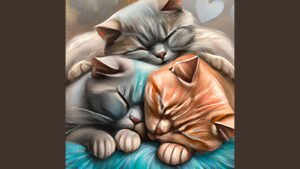Hello, fellow felines and devoted humans! We all know that as cats, we pride ourselves on our appearance. Our fur and whiskers are not just for show – they’re vital to our health and well-being. Keeping them in top shape is essential for a happy, healthy life. Today, we’re sharing some pawsome health tips to ensure our fur is sleek and our whiskers are at their best. Let’s dive in!
1. A Balanced Diet for Beautiful Fur
The foundation of healthy fur and whiskers starts with what we eat. A balanced diet rich in essential nutrients is crucial for maintaining our coat’s lustre and strength. Here’s what to focus on:
- High-Quality Protein: Our bodies thrive on protein. It’s the building block of strong, healthy fur. Ensure our diet includes high-quality sources of protein, such as chicken, fish, or beef.
- Omega-3 and Omega-6 Fatty Acids: These fatty acids are vital for a shiny, well-moisturized coat. Foods rich in omega-3 and omega-6, like fish oil and flaxseed, can help reduce dryness and flakiness.
- Vitamins and Minerals: Vitamins A, E, and B-complex, along with minerals like zinc and copper, are essential for healthy skin and fur. Look for cat foods that provide a balanced mix of these nutrients.
- Hydration: Staying hydrated is key to preventing dry, brittle fur. Always have fresh water available and consider incorporating wet food into our diet to increase water intake.

2. Regular Grooming Sessions
Grooming is not just about looking good; it’s also about staying healthy. Regular grooming helps remove loose fur, prevent matting, and distribute natural oils throughout our coats. Here’s how to make grooming a pleasant and beneficial experience:
- Brushing: Depending on our fur type, we may need daily or weekly brushing. Long-haired cats require more frequent brushing to prevent tangles and mats, while short-haired cats benefit from weekly sessions to remove loose fur.
- Gentle Tools: Use the right grooming tools for our fur type. A slicker brush, bristle brush, or comb can work wonders. Be gentle to avoid pulling or irritating our skin.
- Positive Reinforcement: Make grooming sessions enjoyable by using treats and praise. Start with short sessions and gradually increase the time as we become more comfortable.
- Check for Issues: Grooming is a great time to check for skin issues, parasites, or abnormalities. If you notice anything unusual, consult your vet.
3. Bath Time Bliss
While many of us are not fond of water, occasional baths can help keep our fur clean and healthy, especially if we get into something sticky or dirty. Here’s how to make bath time less stressful:
- Cat-Safe Shampoo: Use a shampoo specifically designed for cats. Human shampoos can be too harsh and may irritate our skin.
- Lukewarm Water: Ensure the water is lukewarm, not too hot or cold. Fill the tub or sink with just enough water to reach our bellies.
- Calm Environment: Create a calm and quiet environment. Speak softly and reassure us throughout the bath.
- Thorough Rinse: Rinse thoroughly to remove all shampoo residue. Leftover shampoo can cause skin irritation.
- Drying Off: Gently pat us dry with a towel. Avoid using a hairdryer, as the noise and heat can be stressful. Allow us to air dry in a warm, draft-free room.

4. Whisker Care
Our whiskers are incredibly sensitive and serve as important sensory tools. Here’s how to keep them in top shape:
- Avoid Trimming: Never trim our whiskers. They help us navigate our environment and judge the width of openings. Trimming can cause disorientation and stress.
- Whisker-Friendly Bowls: Use shallow, wide bowls for food and water to prevent “whisker fatigue.” Deep, narrow bowls can cause discomfort as our whiskers touch the sides.
- Observe Whisker Health: Healthy whiskers are long and evenly spaced. If you notice broken or uneven whiskers, it could indicate stress or health issues. Consult your vet if you have concerns.
5. Stress Management
Stress can take a toll on our fur and overall health. Here are some tips to keep us calm and stress-free:
- Safe Spaces: Provide safe, quiet spaces where we can retreat and relax. High perches, cosy beds, and hiding spots can help us feel secure.
- Routine: We thrive on routine. Consistent feeding, play, and grooming times help us feel safe and reduce anxiety.
- Interactive Play: Engage us in regular play sessions to keep us mentally and physically stimulated. Use toys that mimic hunting behaviours, such as feather wands and laser pointers.
- Environmental Enrichment: Enrich our environment with scratching posts, climbing trees, and puzzle feeders. These additions keep us entertained and reduce boredom-related stress.

6. Regular Health Check-Ups
Regular health check-ups are essential for catching and addressing health issues before they affect our fur and whiskers. Here’s what to expect during a check-up:
- Skin and Coat Examination: Your vet will check for signs of parasites, skin infections, or allergies that could affect our fur.
- Nutritional Advice: Your vet can recommend dietary adjustments if needed to ensure we’re getting the right nutrients for a healthy coat.
- Preventative Care: Regular check-ups help catch issues early, ensuring we stay healthy and happy.
7. Addressing Health Issues
If you notice any changes in our fur or whiskers, it’s important to address them promptly. Here are some common issues and how to handle them:
- Hair Loss: Hair loss can be caused by stress, allergies, or underlying health issues. Consult your vet to determine the cause and appropriate treatment.
- Dry, Flaky Skin: Dry, flaky skin can indicate poor nutrition, allergies, or environmental factors. Improve our diet and consult your vet for further advice.
- Excessive Shedding: While some shedding is normal, excessive shedding can indicate stress, poor diet, or health issues. Regular grooming and a balanced diet can help reduce shedding.
- Parasites: Fleas, ticks, and mites can cause discomfort and affect our fur. Use vet-recommended parasite prevention treatments and regularly check for signs of infestation.
Conclusion
Keeping our fur and whiskers in top shape is essential for our overall health and happiness. With a balanced diet, regular grooming, stress management, and proper care, you can ensure we look and feel our best. Remember, a healthy cat is a happy cat, and our well-being starts with the care and attention you provide.
So, let’s work together to keep our fur sleek, our whiskers strong, and our spirits high. With these pawsome health tips, we’re sure to shine bright and purr loud. Until next time, stay fabulous and keep those grooming sessions coming! 🐾✨😺
Check out The Furminator on Amazon




